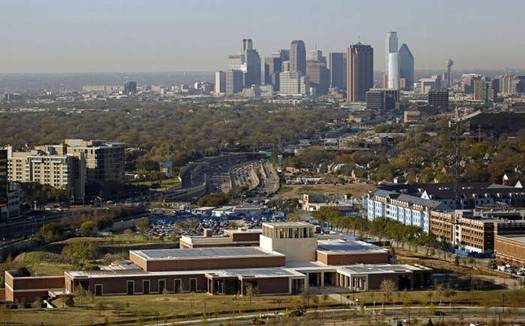
Photo: G.J. McCarthy, Dallas Morning News
My first review as architecture critic of the Dallas Morning News ran this past weekend, an examination of the George W. Bush Presidential Center. The complex houses three functions — a library, a museum, and a policy institute. The design is by Bob Stern, with landscaping and an attached park by Michael Van Valkenburgh. As I write:.
When George W. Bush arrived in the nation’s capital in the winter of 2000, he did so promising an era of “compassionate conservatism.” Some 13 years later, that same impulse toward a soothing and restorative traditionalism animates the design of his presidential library....Set back behind an expansive lawn of native grasses and a colonnaded courtyard, the George W. Bush Presidential Center presents a sober, foursquare face to the world, as if it were trying to be both monumental and modest at once. Designed by New York architect Robert A.M. Stern, it seems decidedly undecided about its place in the world, trading in the language of architectures past while claiming, without much conviction, the mantle of the present. Everywhere competent, it nowhere rises to a level of inspiration.Beyond aesthetics, my central concern about this project is the close and unhealthy proximity in which it places the federally administered presidential archive and a public policy institute, which is independent.
The piece concludes:
“The mixture of architecture and ideology makes for a powerful but dangerous cocktail,” Stern wrote recently. From the outset, the idea at the Bush Center seems to have been to take the sting out of the drink, a perhaps futile gesture. In practice, its conservative dress is as deceptive as it is compassionate, cloaking a hulking core in a historicist skin. While Dallas rushes headlong into the future, the Bush Center seems stuck in a past of its own invention.I should note here that the quote is drawn from Stern's introduction to the recently re-published Albert Speer monograph authored by Leon Krier. In addition to the review, I also conducted an interview with Stern regarding the design. A sample:
How would you describe your architecture?To state the obvious, this has been a challenging and controversial project. I was especially pleased that it was featured prominently "above the fold" on the front page of the Sunday paper. That speaks to the importance of the project in the city, but also to a general interest in architectural criticism here, and that is a very good thing indeed.
I’m a modern traditionalist.What does that mean?
Why do you think the Bushes selected you?
I like to look back to traditions — not only the way things looked in the past, but how they were composed and conceptualized, and then address contemporary problems based on that understanding and knowledge. This is not a building that has a full panoply of classical motifs. But it is a building that has the discipline of classical architecture. I would like to think that it speaks to this moment but also much longer into the future. There are many buildings that are up to the minute, but the minute goes, the clock ticks, and sometimes buildings are trapped in their moment.
I think I was chosen because I have a pretty good working knowledge of history, American history especially; I have a sense that a building is not about me but is about the purpose of the building; and I have an ability to make buildings that have high integrity but are also accessible to a lot of people. This is a building where people will come in pickup trucks and RVs. It’s a building for the American people as a whole, and so it has to be understood and appreciated by a wide and diverse public. President Bush may be a controversial figure, but he has enormous affection in a wide number of people in America.
@marklamster
